Chapter 18.19
MIXED USE OVERLAY ZONE (MUO)
Sections:
18.19.010 Mixed use overlay zone (MUO).
18.19.015 Superimposed nature of mixed use overlay zone.
18.19.020 Special focus areas.
18.19.025 Mixed use in other areas.
18.19.040 Uses permitted subject to a conditional use permit.
18.19.060 Property development standards.
18.19.080 Phasing of mixed use developments.
18.19.010 Mixed use overlay zone (MUO).
The mixed use overlay zone is intended to allow greater flexibility of development alternatives, especially attractive higher density residential development and live-work buildings, in appropriate areas of the city. More specifically, the intent of the mixed use overlay zone is to accomplish the following objectives:
A. To encourage mixed use projects that combine residential with nonresidential uses in the same building or building site area as a means to create an active street life, enhance the vitality of businesses, and reduce the need for automobile travel;
B. To provide a meaningful blend of residential and nonresidential uses that enhances and builds upon the city’s commercial base;
C. To provide additional housing options for people, including but not limited to, young professionals and older people, who want to live near their workplace and/or near retail and other non-residential uses;
D. To encourage consolidation of small parcels into viable, block-size mixed use development in designated areas;
E. To ensure on-site compatibility of residential and non-residential uses; and
F. To ensure compatibility of mixed use projects with surrounding uses and development patterns. (Ord. 1820 § 5 (part), 2020; Ord. 1683 § 17, 2006; Urg. Ord. 1682)
18.19.015 Superimposed nature of mixed use overlay zone.
The mixed use overlay zone shall be in the nature of an overlay zone. Land classified in the mixed use overlay zone shall also be classified in one or more underlying zones. Property so classified shall be identified on the zoning map by both the underlying zone and the mixed use overlay zone. The regulations set forth in this chapter of the mixed use overlay zone shall be in addition to those regulations set forth in the underlying zone. In the event of a conflict between the provisions of the mixed use overlay zone and the provisions of the underlying zone, the provisions of the mixed use overlay zone shall prevail when a mixed use project is being developed. If the mixed use overlay zone is silent in relation to any development standard, the development standard identified in the underlying zone shall prevail. (Ord. 1738 § 42 (part), 2012: Ord. 1683 § 17, 2006; Urg. Ord. 1682)
18.19.020 Special focus areas.
With application of the mixed use overlay zone, the city seeks to take advantage of development opportunities in key areas of the city, each of which faces unique opportunities and constraints. A description of the desired purpose for four of these areas is described in this section to provide guidance for those seeking to construct mixed use development in such areas. In cases of conflict between the areas described below and the zoning map, the zoning map shall prevail.
A. Rosecrans Avenue Corridor (generally those parcels abutting Rosecrans Avenue and those properties north of 145th as shown below): Land use needs for this area include retail and eating establishments to serve the needs of Gardena residents. The primary objective for such uses is to provide residents with an attractive alternative to obtaining goods and services in nearby cities.
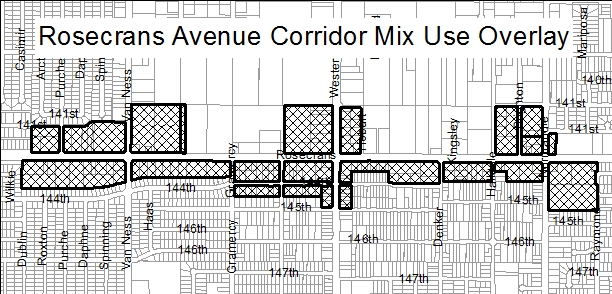
B. Western Avenue Corridor North (generally those parcels abutting Western Avenue, north of Redondo Beach Boulevard and south of 145th as shown below): Land uses in this area are intended to emphasize office and service uses in combination with attached residential uses. The parcel and street configuration of land within this focus area dictates that development will be smaller and potentially more incremental in nature. Accordingly, parcels within each block should be developed as one cohesive project where possible. Development of multiple blocks as one project is highly encouraged. Access from existing alleyways will permit rear vehicular access, while minimizing curb cuts along Western Avenue.

C. Western Addition (parcels abutting Western Avenue north of 169th and south of Redondo Beach Boulevard as shown below): By integrating commercial and residential uses, including live-work buildings, this area will function as a transition from the industrially zoned properties to the south to the residentially zoned properties to the north. Additionally, development in this area should respect and relate to the character of the Civic Center area located nearby. The objective for this area is to develop one large or a group of mixed use developments that work together to create a unified sense of place and purpose.
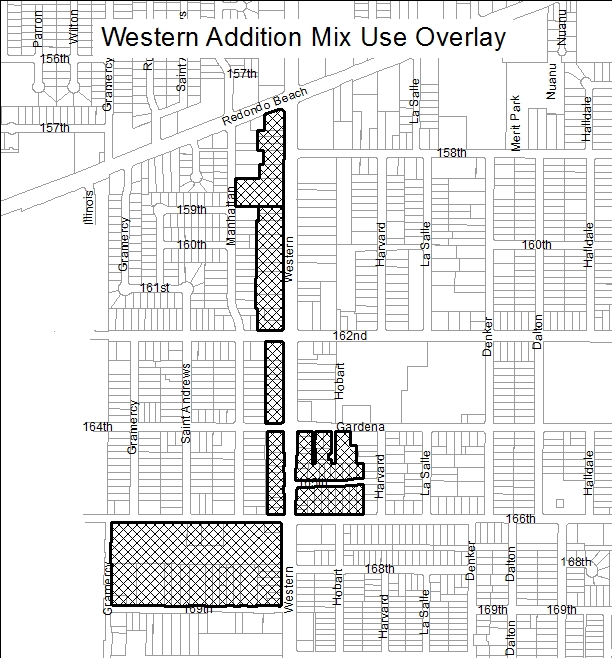
D. Dominguez Channel (approximately twenty-acre area bounded by Western Avenue, 178th Street, and Dominguez Channel): This area provides an opportunity to plan complementary development and defined connections to the Artesia Corridor Specific Plan, opposite Dominguez Channel to the north. Recreational opportunities are anticipated to occur within the Dominguez Channel easement, and consequently adjacent uses should take advantage of this situation by locating parks and open spaces along the Dominguez Channel edge. In addition, the Dominguez Channel area has the opportunity to serve as a gateway to Gardena, due to its location at the southern border of the city. Accordingly, the objective for this area is also to develop one large or a group of mixed use developments that work together to create a unified sense of place and purpose.
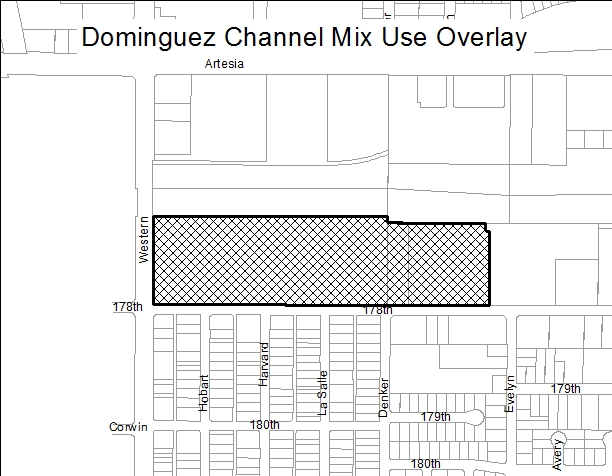
(Ord. 1873 § 1, 2024; Ord. 1848 § 15, 2023; Ord. 1847 § 15, 2023; Ord. 1738 § 42 (part), 2012: Ord. 1683 § 17, 2006; Urg. Ord. 1682)
18.19.025 Mixed use in other areas.
Applications may be made to place the mixed use overlay zone on other properties in the city in accordance with the procedures set forth in Chapter 18.52. The planning commission and city council shall consider whether a mixed use development is appropriate in its context with adjacent land uses and serves the needs of residents in an attractive and functional manner. (Ord. 1738 § 42 (part), 2012)
18.19.030 Uses permitted.
The following uses shall be permitted in the mixed use overlay zone:
A. All mixed use development in accordance with the provisions of this section requires site plan review pursuant to the standards of this title. Site plans shall be subject to planning commission review and approval.
B. Property may be developed solely for residential uses or solely for uses permitted or conditionally permitted in accordance with the provisions of the underlying zoning district.
1. If developed in accordance with the provisions of the underlying zoning district, site plan review shall not be required for such development unless required by another provision of this title.
2. If developed solely for residential purposes, development shall be in accordance with the provisions of this chapter for residential development and site plan review shall be required.
C. If property is developed with a mix of residential and nonresidential uses1 within the same project area in accordance with the provisions of this section:
1. Residential:
a. Multifamily dwellings;
b. Single-family attached dwellings;
c. Live-work uses;2
d. Transitional housing, subject only to those restrictions that apply to other residential dwellings of the same type in this zone;
e. Supportive housing, subject only to those restrictions that apply to other residential dwellings of the same type in this zone.
2. Commercial:
a. Food sales and service:
i. Confectionery, candy stores, retail bakery;
ii. Neighborhood markets;
iii. Restaurants, coffee shops, cafeterias (sit-down and/or take-out).
b. Health services:
i. Medical, dental, optical offices;
ii. Pharmacies (walk-in);
iii. Health clubs of less than ten thousand square feet.
c. Administrative, financial, real estate, bank and professional offices.
d. Retail sales and service:
i. Antique stores;
ii. Art and photography galleries and studios;
iii. Automobile supply stores;
iv. Barber shops and beauty shops;
v. Blueprinting and photocopying;
vi. Book and stationary stores;
vii. Clothing stores of less than five thousand square feet;
viii. Department and furniture stores of less than five thousand square feet;
ix. Dry cleaning service;
x. Florists and plant shops;
xi. Furniture upholstery shops;
xii. Gift shops;
xiii. Hardware and paint stores of less than five thousand square feet;
xiv. Interior decorating services;
xv. Jewelry stores;
xvi. Music and vocal instruction and dancing academies;
xvii. Pet shops;
xviii. Postal facilities (private);
xix. Repair services (limited);
xx. Shoe sales;
xxi. Tailor;
xxii. Television, radio, and home appliance stores of less than five thousand square feet.
3. Public facilities:
a. Fire and police stations;
b. Libraries;
c. Post offices.
4. Live-work:
a. Professional, administrative, and business uses;
b. Repair services (excluding auto related repair services);
c. Retail sales and service;
d. Studios (art, photography, copywriter, film/video).
5. Accessory:
a. Parking lots or structures,
b. Public or private recreational facilities,
c. Mechanical and utility equipment.
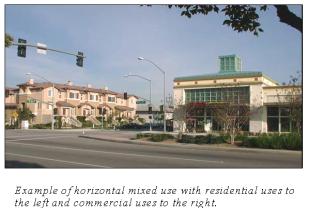
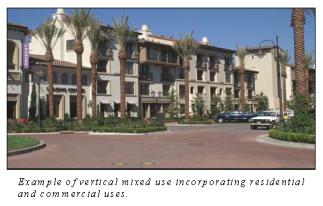
(Ord. 1873 § 1, 2024; Ord. 1848 § 3, 2023; Ord. 1847 § 3, 2023; Ord. 1820 § 5 (part), 2020; Ord. 1807 § 2, 2019; Ord. 1757 § 1, 2015; Ord. 1738 § 42 (part), 2012; Ord. 1714 § 2(C) and (D), 2010; Ord. 1683 § 17, 2006; Urg. Ord. 1682)
18.19.040 Uses permitted subject to a conditional use permit.
The following uses may be permitted in a mixed use development under a conditional use permit in accordance with the procedures set forth in Chapter 18.46:
A. Bars and nightclubs;
B. Restaurants, coffee shops (drive-thru);
C. Supermarkets;
D. Public assembly:
1. Lodges and meeting halls,
2. Museums,
3. Theaters (cinema and otherwise);
E. Pharmacies (drive-thru);
F. Health clubs of more than ten thousand square feet;
G. Retail sales and service:
1. Clothing stores of more than five thousand square feet,
2. Department and furniture stores of more than five thousand square feet,
3. Hardware and paint stores of more than five thousand square feet,
4. Television, radio, and home appliance stores of more than five thousand square feet;
H. Computer internet and amusement facilities;
I. Live-work in conjunction with:
1. Restaurants; or
2. Any use that may result in exterior or interior noise levels in excess of city residential noise standards;
J. Churches;
K. Massage establishments that are not otherwise subject to an exception pursuant to Section 5.48.030, except no massage establishment shall be allowed to locate in a live-work unit;
L. Cigar and hookah lounges in compliance with Section 18.46.030(C)(30). (Ord. 1871 § 3, 2024; Ord. 1757 § 2, 2015; Ord. 1738 § 42 (part), 2012; Ord. 1714 § 2(E), 2010; Ord. 1683 § 17, 2006; Urg. Ord. 1682)
18.19.050 Uses prohibited.
A. All uses not listed in Sections 18.19.030 and 18.19.040 are deemed to be expressly prohibited in the MUO zone, except those determined to be similar pursuant to the provisions of Section 18.42.040;
B. Home sharing rentals; and
C. Short-term rentals;
D. Significant tobacco retailers. (Ord. 1871 § 3, 2024; Ord. 1854 § 10, 2023; Ord. 1820 § 6, 2020: Ord. 1738 § 42 (part), 2012: Ord. 1683 § 17, 2006; Urg. Ord. 1682)
18.19.060 Property development standards.
The property development standards set forth in this section shall apply to all land and buildings built within the mixed use overlay zone, when a property owner chooses to provide housing in association with non-residential uses in accordance with the provisions of said zone.
A. Lot dimensions: minimum lot width at street frontage of eighty feet with curb cuts along building frontage, fifty feet without curb cuts along building frontage. No minimum or maximum lot depth.
B. Minimum project area3:
1. One-half acre minimum.
2. Lots separated by public roadways may be consolidated to create larger project areas.
3. The community development director must be consulted before the review of projects that cause an orphaned parcel condition. An orphaned parcel condition exists if the group of consolidated parcels that comprise the minimum project area of one-half acre results in an adjacent isolated or orphaned parcel that will be unable to meet the minimum project area. The involvement of the community development director ensures that adequate effort has been made to negotiate between the project and adjacent orphaned parcel. In addition, in the event that the orphaned parcel is not included in the adjacent development for reasons such as its recent date of development, the involvement of the community development director will ensure that compatibility exists between the orphaned parcel’s existing condition and the adjacent project’s current development.
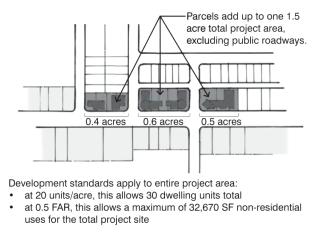
C. Density and intensity:
1. Floor area ratio (FAR)4: nonresidential intensity shall be a maximum of 0.5 FAR as calculated over the portion of the project area devoted to such use, including when such use is part of a vertical development.
2. For mixed use projects approved after August 1, 2012, the minimum permitted residential density shall be twenty units per acre for any residential development. This subsection shall not apply to the expansion of any existing use.
3. Residential by itself or as part of a mixed use project: the maximum residential density shall be as follows, calculated over the portion of the project area devoted to residential, including when part of a vertical development:
a. Twenty-five units per acre maximum for sites less than one-half acre;
b. Thirty units per acre maximum for sites at least one-half acre but less than one acre.
4. Projects may develop both the maximum FAR for nonresidential development and maximum density for residential development within the same project area, provided all other standards in this section are met.
5. Site coverage: eighty percent.
D. Dwelling unit size:
1. A minimum of four hundred square feet per unit;
2. No minimum dwelling unit size shall be required for an affordable housing unit where the applicant enters into an affordable housing agreement with the city to be recorded against the property to ensure continued affordability of all moderate, low, and very low income rental units for at least fifty-five years or where the applicant enters into an equity sharing agreement for all for-sale affordable housing units upon the same terms and conditions as in Section 18.43.045(D).
E. Maximum building height: the following height standards apply to individual buildings within a project area5:
1. Forty feet, with an additional five feet for architectural projections if6:
a. Adjacent to single-family (R-1) or low-density multifamily residential (R-2) zone; or
b. Adjacent to a collector or major collector street.
2. Fifty-five feet, with an additional five feet for architectural projections if:
a. Adjacent to any use other than single-family (R-1) or low-density multifamily (R-2) residential zones; or
b. Adjacent to an arterial street.
F. Yards: for mixed use projects, setbacks are calculated from the project boundaries and not from individual units or buildings within the development.
1. Front yard setback:
a. Five feet from the public right-of-way for vertical residential developments that do not have front doors facing the street;
b. Twenty feet from the public right-of-way for residential developments that have front doors which face onto the street; and
c. A minimum of twelve feet from face of curb and a maximum of twenty feet from face of curb for all other developments;
2. Side yard setback:
a. A minimum of ten feet when the building is thirty-five feet in height or less, including architectural projections, and the property directly abuts parcels zoned R-1 or R-2;
b. A minimum of fifteen feet when the building exceeds thirty-five feet in height, including architectural projections, and the property directly abuts parcels zoned R-1 or R-2;
c. A minimum of five feet when the property does not directly abut parcels zoned R-1 or R-2, unless the property is a corner lot in which case, the street side must be a minimum of ten feet;
3. Rear yard setback:
a. A minimum of fifteen feet when the building exceeds thirty-five feet in height, including architectural projections, and the property directly abuts parcels zoned R-1 or R-2;
b. A minimum of ten feet when the building is thirty-five feet in height or less, including architectural projections, and the property directly abuts parcels zoned R-1 or R-2;
c. A minimum of five feet when the property does not directly abut parcels zoned R-1 or R-2, unless the property is a corner lot in which case, the street side must be a minimum of ten feet.
G. Accessory buildings: an accessory building, including garage, may be constructed within five feet of rear and side property line (or edge of alley right-of-way) when located in the rear one-third of the lot. Garages fronting on public streets shall maintain a minimum eight-foot setback from the property line. All single tenant garages shall be provided with automatic garage doors.
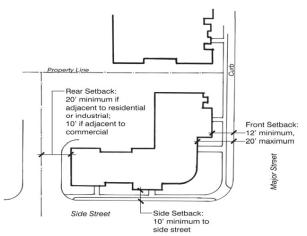
Diagram of yard setbacks.
H. Distances between buildings on the same site: Notwithstanding any other provision of this code to the contrary, the following shall apply:
|
|
Height – 40' or less |
Height – Greater than 40' |
|---|---|---|
|
Adjacent to commercial |
10' |
15' |
|
Side to side – detached home |
6' – if openings are offset from adjacent openings; otherwise 10' |
10' – if openings are offset from adjacent openings; otherwise 15' |
|
Side to side – attached condominium buildings |
10' |
15' |
|
Front to front with interior court |
10' |
15' |
|
Front to front with driveway between structures |
30' |
30' |
|
Main to accessory building |
6' |
6' |
I. Live/work standards: live/work units and buildings are subject to the following standards:
1. Work on the premises of a live/work unit shall be limited to persons who live in the live/work unit. Living and working spaces shall not be rented or sold separately. The owner/occupant of a live/work unit shall notify the City of any change in use or occupancy. Any change of use or occupancy shall comply with the uses identified in this section and will require a new Certificate of Occupancy. The commercial square footage initially approved for live-work areas within a unit shall remain commercial in nature and shall not be converted to residential use with subsequent owners.
2. Off-street loading will be accomplished by the temporary use of planned parking spaces, or in parking spaces limiting a vehicle’s permitted parking time (e.g., parking stalls designated with twenty minute parking limits).
3. Live/work units and buildings must comply with any requirements imposed by the building, fire, community development, police, and public works departments intended to protect the public health, safety and welfare.
4. An administrative approval or conditional approval of the commercial/work component of the live/work units shall be granted to the owner of the unit. Approvals of commercial uses may not be transferred between units. A copy of all conditions of the approval of the project shall be provided to all future owners/occupants of the building prior to their execution of a lease or purchase agreement for the live/work unit. Project conditions are required to be recorded with the County Recorder’s Office prior to exercise of entitlement.
5. Businesses using commercial vehicles are prohibited.
J. Usable open space:
1. Residential uses: a minimum of one hundred fifty square feet of outdoor usable common or private open space shall be provided per dwelling unit in accordance with the requirements of Section 18.42.065.
2. Live/work uses: a minimum of one hundred square feet of either outdoor usable common or private open space shall be provided for each live/work unit in accordance with the requirements of Section 18.42.065.
3. The usable common open space requirements of residential mixed use and live/work units can be combined into one or more large spaces to satisfy the open space requirements, so long as the space is located along or directly accessed and visible from perimeter or interior streets.
K. Off-street parking: the provisions of Chapter 18.40 shall apply, with the following exceptions:
1. Residential and live/work parking: parking requirements for residential or live/work units may be satisfied by tandem parking. Guest spaces may not be tandem. Tandem garage parking shall be no smaller than ten and one-half feet wide by thirty-eight feet long, as measured from the interior walls;
2. No curb cuts are allowed for lots less than twenty thousand square feet that abut alleys;
3. Bachelor/efficiency units: one space shall be required for each unit;
4. Live/work units: two resident spaces and 0.5 guest spaces per unit. Resident spaces shall be covered; guest spaces may be uncovered. Three additional parking spaces shall be provided for every one thousand square feet of nonresidential square footage; except that ten additional parking spaces shall be provided for every one thousand square feet of restaurant uses; parking spaces for nonresidential uses may be uncovered;
5. Shared parking is allowed subsequent to a shared parking analysis, prepared by a California-licensed, independent traffic engineer, at the developer’s expense, and approved by the community development director;
6. Due to variations in parking demand and needs of mixed use projects, vehicle parking requirements and the design of the parking areas, including ingress and egress, may be reduced or modified as part of the site plan review process, by the planning commission, based upon information contained in a parking demand study prepared by a California-licensed, independent traffic engineer, at the developer’s expense;
7. Parking for any residences shall be secured and separated from public parking;
8. Assigned parking shall be provided within one hundred fifty feet of the front entrance of the dwelling unit for which it serves;
9. An above- or below-grade parking structure is permitted subject to the following standards:
a. Entrance and exit to garage shall be from side-street or rear of primary building,
b. If the parking structure has retail, office or similar uses on the street-level floor on the side facing the street, the minimum front or side garage setback may be reduced from minimum eight feet from the property line to zero feet (providing that the building allows for an enhanced walkway with landscaping or streetscape elements as depicted in Section 18.19.070 within the twelve-foot yard setback from the face of the curb), subject to site plan review and approval per Chapter 18.44.
L. Circulation and access: all lots and project sites that abut existing alleys shall take primary vehicular access (parking, deliveries, loading and unloading) from alley. Project sites or lots which abut Western Avenue or Crenshaw Boulevard shall dedicate a minimum twenty-four-foot-wide easement, or at dimensions specified by the consolidated fire protection district of Los Angeles County, for alleyway purposes. This requirement may be waived as part of the site plan review process if it is determined that lot dimensions or external physical constraints preclude extension of alley.
M. Storage space: a minimum of one hundred twenty cubic feet of storage space shall be provided for each dwelling unit with a minimum of two feet in any direction. For dwelling units without a private parking garage, general storage cabinets/closets are encouraged to be located within the parking area, in close proximity to the respective units, or below interior stairways.
N. Signs: the provisions of Chapter 18.58 shall apply.
O. General provisions as set forth in the table found in Section 18.42.010. (Ord. 1873 § 1, 2024; Ord. 1848 §§ 3, 16, 2023; Ord. 1847 §§ 3, 16, 2023; Ord. 1820 § 7, 2020; Ord. 1804 §§ 7, 8, 2019; Ord. 1738 § 42 (part), 2012; Ord. 1737 § 9, 2012; Ord. 1683 § 17, 2006; Urg. Ord. 1682)
18.19.070 Design principles.
The design principles set forth in this section shall be used to review site plans, building plans and use permits for all mixed use projects proposed on land within the mixed use overlay zone. These design principles aim to create guidelines for the public space between the street and adjacent building that promote visual interest and pedestrian activity. This transitional space is defined by the site design, architecture, and streetscape elements.
A. Site design: the following principles intend to establish an engaging street edge defined by the orientation and placement of buildings fronting major streets.
1. Building orientation: buildings and major pedestrian entrances should be oriented towards centers of activity, such as the primary street frontage or public plazas:
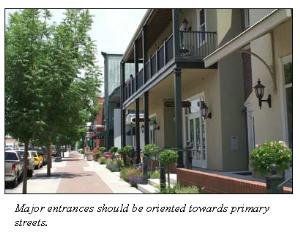
(a) All primary ground-floor common entries or individual dwelling unit entries fronting on streets should be oriented to the street, not to the interior or to a parking lot. Entrances at building corners may be used to satisfy this requirement;
2. Building facade: the building placement should enforce a continuous street edge establishing a strong pedestrian corridor. However, long, unarticulated building facades should be eliminated with variation in setbacks:
(a) Variable setbacks: setbacks should vary by a minimum of ten inches each twenty-five feet in order to break up long, bland unarticulated building facades,
(b) In addition to creating visual interest, building setbacks should establish space for pedestrian plazas, courtyards, or outside dining areas. Setbacks should not generate unusable or dead space;
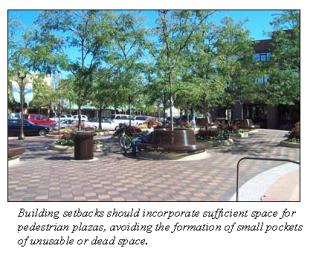
3. Setback encroachments: restaurant facilities and retail may encroach into the street setback as permitted by the City under an approved encroachment permit under the following principles:
a. Uses should add color and activity to the street such as outdoor eating areas or flower vendors,
b. Outdoor dining, outdoor displays, or any other ancillary use as approved by the community development director may encroach into the sidewalk area a maximum of eight feet from the building frontage, so long as at least four feet of unobstructed walkway is maintained;
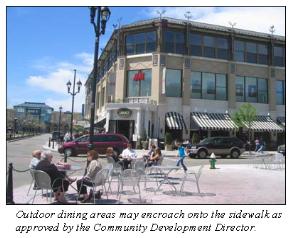
4. Pedestrian circulation should be continuous and provide connectivity between appropriate uses:
a. Pedestrian pathways should connect to appropriate off-site uses, including off-site transit stops and parking;
b. Pedestrian pathways should be clearly marked;

c. Street-side facades may be divided to form pedestrian spaces such as public plazas, private pocket parks, outdoor dining, and other pedestrian-oriented amenities to promote pedestrian activity;
5. Vehicular circulation should be designed to serve uses appropriately and employ traffic calming measures to ensure pedestrian safety:
a. Maximize access and connectivity while minimizing curb cuts to major roadways,
b. Alleyways shall be designed to ensure safe and continuous traffic flow, minimizing direct connections to public roadways,
c. Prevent bypass alternate routes to minimize traffic conflicts and enhance pedestrian circulation,
d. Use of neck-downs, bulb-outs, and other traffic calming measures are encouraged.
B. Architecture: the following principles intend to promote quality design appearance and visual interest.
1. Architectural styles and scale: building design should incorporate an architectural style and scale that is compatible with nearby uses, provided such uses are similar to uses permitted by this chapter. Architectural details may draw upon locally historic buildings or other nearby features that contribute to the aesthetic ambience of the immediate area;
2. Siding materials: plain concrete block, plain concrete, plywood, sheet pressboard, vinyl, or similar siding materials are strongly discouraged. Siding should be of high quality materials that weather well over time. Materials and colors should be compatible with the architectural style;
3. Color: colors should include a base color and accent colors. Generally, a minimum of three complementary colors should be used for each building. Color schemes should be selected with a harmonious range of accent materials;
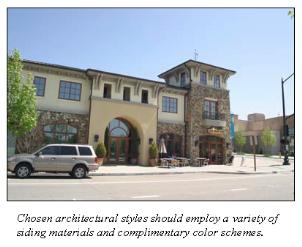
4. Multiple story structures: each subsequent story above the second story shall be set back from the story below by a minimum of eight feet. Architectural features, private open spaces, and patios may encroach up to fifty percent into the multiple story setback area, up to the wall face of the lower story, to create interest in building mass;
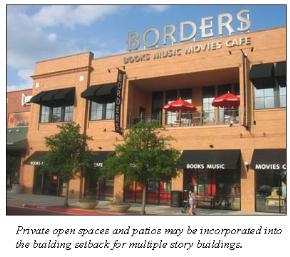
5. Corner buildings: buildings at corners of intersections should receive special architectural treatment to enhance the pedestrian experience, such as building cut-offs and corner entrances with additional architectural detail;
6. Building facade: street-facing facades should be visually open to major streets and architecturally enhanced through the use of the architectural features listed below. Maximum total wall plane without windows or entrances (on any facade) should not exceed thirty percent of the first story wall. A minimum of sixty percent of the street-facing facade between two feet and eight feet in height must be comprised of clear windows that allow views of indoor space or product display areas;

7. Architectural features are encouraged to create visual interest. The architectural details listed below should adhere to the following guidelines:
a. The following architectural projections may encroach into the required setback by up to eighteen inches: bays, dormer windows, sun-control devices, un-roofed porches, cornices, belt courses and appendages such as water tables, sills, capitals, and bases,
b. Balconies and porches are encouraged to create distinction between units,
c. Awnings should be broken into segments that mirror the door and window openings beneath them,
d. Canopies should be limited in width and supporting posts should not be placed within the public right-of-way,
e. Trim detail on rooflines, porches, windows and doors on street-facing elevations are encouraged;
8. Window placement should reflect the desired exposure appropriate for the respective use:
a. For commercial uses, large windows should front onto major pedestrian throughways to promote exposure and visibility,
b. For residential uses, windows should face away from loading areas, docks, and trash storage areas. In the occasion that residential windows face one another, windows should be offset to maximize privacy.
C. Streetscape: the following streetscape elements augment architectural styles of the area and promote pedestrian activity. These interactive elements enhance usable pedestrian space and decrease the possibility of dead space.
1. Landscaping is encouraged and should be well maintained and complement the adjacent project:
a. Landscaping should be selected at a scale that is consistent with the building site,
b. Street landscaping should be appropriate for sidewalk environments to limit the potential of root systems to affect the adjacent sidewalks,
c. Landscaping should not interfere with pedestrian movement or impede with the visibility of business and signage;
2. Furniture: Benches, seating areas, kiosks, and shade structures should be incorporated as amenities for pedestrians:
a. Furnishings should be placed where pedestrian traffic, viewsheds, or building ingress and egress will not be obstructed,
b. Furnishings should be constructed of durable, high quality materials that can withstand the elements without showing wear,
c. Furniture design should be complementary to the architectural styles of the area;

3. Public art and water features should be used to highlight public spaces and create points of interest for each project. These streetscape elements should be well maintained and used as accent features;
4. Paving materials: use of distinctive paving treatments is encouraged to give visual cues to users and emphasize different areas within the streetscape and public spaces. Painted paving surfaces should not be used except to indicate traffic lanes or parking spaces;

5. Walls, fences, and gates should be used to identify separate areas and provide needed privacy and security:
a. Although necessary in certain locations, solid walls should only be used when absolutely necessary,
b. Walls, fences, and gates should appear consistent in style and material, complementing the surrounding architectural styles,
c. Landscaping elements should be densely planted and layered to provide screening. Vines and trellises are encouraged to help soften hard edges and screen walls from view;
6. Lighting should be used to illuminate public spaces and contribute to the safety and beauty of the project:
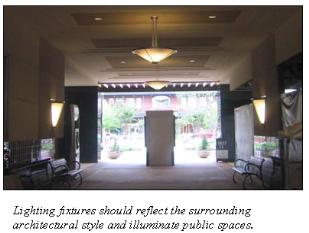
a. Fixtures should be complementary to the architectural styles of the area,
b. Overly glaring or flashing lights are discouraged;
7. Signage should be used to identify places, provide direction, and advertise businesses. Along with communicating information, signage should add to the character of each project and reinforce a sense of place:
a. Signs shall consist of high quality materials and color palettes that reflect the architectural themes of the surrounding area,
b. Location and placement of signs should not obstruct pedestrian or vehicular movement.
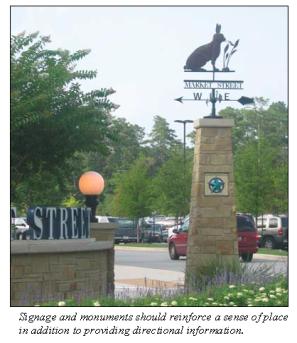
(Ord. 1738 § 42 (part), 2012; Ord. 1683 § 17, 2006; Urg. Ord. 1682)
18.19.080 Phasing of mixed use developments.
New mixed use projects shall include construction of both the residential and nonresidential parts concurrently. (Ord. 1873 § 1, 2024; Ord. 1848 § 17, 2023; Ord. 1847 § 17, 2023)
Mixed use development can be horizontally or vertically integrated. Horizontal mixed use development consists of two or more attached or detached buildings of differing use categories (e.g., residential and commercial) within the same project area. Such buildings do not need to be on the same parcel or even on the same block, but must be within the same project area. Vertical mixed use development consists of one or more different uses placed over another use within the same building (e.g., residential over commercial).
Covenants, conditions and restrictions for individual live-work projects may further restrict and prohibit uses, but shall not be more permissive than uses listed under Section 18.19.020(C)(4). In addition, a Home Occupancy Permit shall be required.
Project area: A project area may encompass a single parcel or multiple parcels, planned and constructed as one coordinated and unified project.
Floor area ratio (FAR): The maximum FAR is calculated as the total square feet of nonresidential building (excluding areas used exclusively for parking), divided by the number of square feet within the project area (excluding areas designated for public roadways, as measured from curb to curb).
Depending on location of buildings with respect to adjacent uses, it is possible for each building within a project area to have a different height limit. If a building abuts multiple roadway classifications and/or uses, the most restrictive standard shall apply.
Architectural projections are building elements (e.g., towers, cupolas) that are added to buildings to provide architectural interest without adding interior floor area. The maximum height of any architectural projection is ten feet unless approved by the community development director following site plan review.


